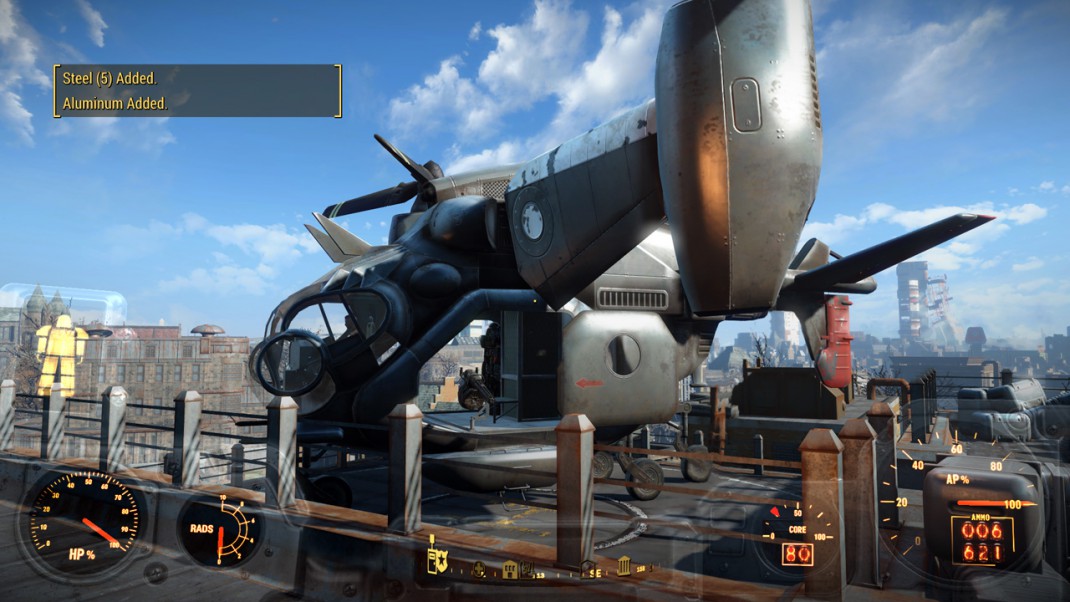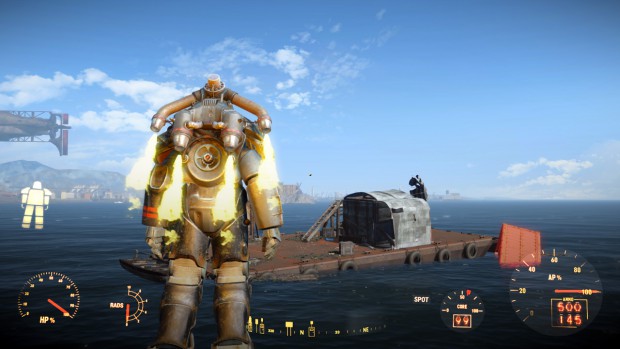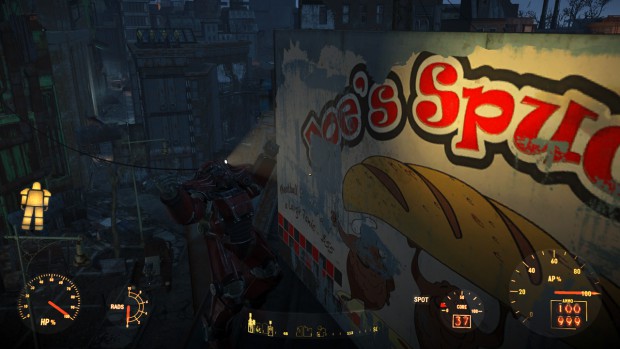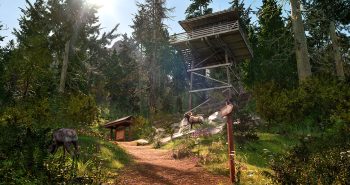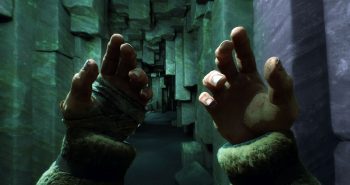“War. War never changes.” This iconic phrase has been synonymous with the Fallout series since the original game was launched back in 1997. The series has seen lots of changes since then. It moved studios, changed genres, and even platforms. This whole, turbulent journey has led us to today. Fallout 4 is out and on store shelves. The game, which is set in 2287, takes place ten years after the events of Fallout 3.
Fallout 4 begins, however, with a very cool prologue sequence that takes place before The Great War begins. It allows you a taste of life before the bombs fell and also serves as a way to create your character. However, in this Fallout game, the character creations has changed quite a bit. Sure, you still have your S.P.E.C.I.A.L. attributes to select, but gone are the individual skills of previous games.
For example, you no longer select and/or level up individual skills. Instead, your S.P.E.C.I.A.L. attributes, and any Perks you have, will be the deciding factor on how you fare in using equipment or fighting, etc. The new system is a bit of a letdown for hardcore RPG gamers. Even in The Elder Scrolls V: Skyrim, you level up individual weapon skills by focusing on using that kind of weapon. You are not good at using all categories of weapons and have to specialize. This brings up a lot of replayability – how would I have done if I were a two-weapon fighter, assassin, etc? In Fallout 4, there is much less specialization and a lot more generalization with regards to skills.
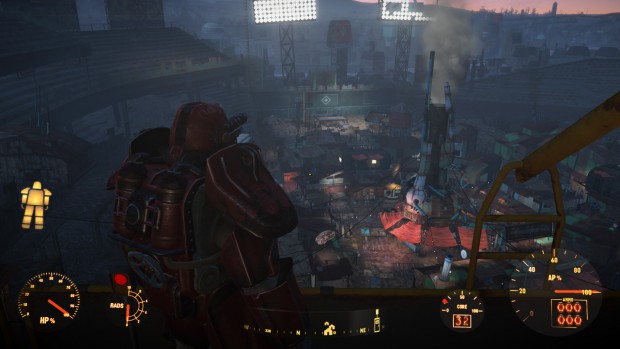
Because of this, the Perks and Magazine systems are more important than ever before. Perks allow you to get bonuses and special abilities in a variety of categories. You can also increase your S.P.E.C.I.A.L. attributes in each of the base Perk types. Magazines, comics, and other pre-war books that you find will give even more bonuses to your skills – some even grant you additional things to build at crafting tables. Additionally, if you travel with any of your companions for some time, and get them to like you by your actions, you will eventually receive special Perks from each one. These could be experience boosts for a specific type of dialog persuasion, etc.
Crafting comes back hard in Fallout 4, with players being able to modify just about any piece of equipment they pick up in the game. The game is set in “The Commonwealth”, the area we now refer to as Massachusetts. This area is replete with its own style of weapons and equipment. Sure, some of the old favorites return, like the minigun, etc but gone are the more realistic weapon types seen in Fallout: New Vegas (Such as the M4 assault rifle). Fallout 4 allows players to take a base weapon and turn it into anything they like. You can start with a standard “Pipe Pistol”, which is a rudimentary firearm from the region. You can then use a Weapons Crafting station and turn it into a Pipe Rifle, a Pipe Submachine Gun, and more. Armor is also interesting, as you can wear full body costumes or instead to opt for base layers like army fatigues, long johns, etc. From there, you add individual armor pieces – chest, right arm, left arm, etc. This will allow you to fully customize not only your stats but, also, your look and style. The mixing and matching is addictive to get just the right amount of defense from your getup.
With this lack of weaponry from previous games, one might think that the game distances itself from previous entries, such as New Vegas. However, that couldn’t be further from the truth. Throughout the game, you will find numerous references to previous Fallout games. These homages and callbacks add a lot to the player universe – especially if you have played the previous games to understand them.
Also new for Fallout 4 is how Power Armor is handled. In past Fallout games, Power Armor was a single suit or piece of armor/apparel. Donning that one piece of armor turned your entire character into a walking chrome menace. I still remember getting that first Power Armor unit in the original Fallout… Good times. In Fallout 4, Power Armor is donned in pieces. Sure, you have the basic Power Armor Frame which is skeletal in nature, but you then equip various pieces of armor you find to that frame. When damaged, specific armor sections will blow off the frame, making for some visually striking combat sequences. While I like the modular nature of this system, it seems to take away the special, rare quality of Power Armor. Now, Power Armor pieces can be found all over the Commonwealth. I found at least three almost-full sets of X-01 advanced prototype armor by just exploring. Raiders have Mad Max style Power Armor components as well – all these pieces means you can Frankenstein together a custom suit of armor segments. A T-45 arm here, T-51 leg there, T-60 torso, X-01 head… In previous games, getting that Power Armor was a big achievement. If you follow Fallout 4’s main storyline, you can get a basic suit of T-45 armor within about 25 minutes.
Another huge update for Fallout 4 is the ability to build up and manage settlements located around the wasteland, starting with your home neighborhood of Sanctuary Hills. Sometimes, you will get word that one of your settlement needs assistance in some way, and these calls for help do expire, at the cost of that settlement in some way (people could die, happiness decreases, etc). You can construct all manner of interesting structures, as defensible as you desire. You can collect a whole slew of power armor throughout the game, so I constructed my own power armor base a la Tony Stark, with multiple racks to display each. The possibilities for creativity are staggering. However, the game never really explains all the ins and outs of the building/workshop system – but, a bit of personal exploration should help with that.
Fallout 4 is, in many ways, a successor to The Elder Scrolls V: Skyrim – in some ways even more than Fallout 3. Even more interesting is what Fallout 4 could mean for The Elder Scrolls saga going forward. Seeing how the settlement building and management system works in Fallout 4, it is totally within the bounds of possibility that our next visit to Tamriel will see the player being able to build/manage villages of their own.
From a story perspective, Bethesda has opted to forego the Fallout trope of having an ending which explains the fate of each faction/city/character. Now, there is a brief ending sequence and you are right back out to continue questing around the wasteland. While some have criticized this, I believe there is a deeper strategy at work. I believe Bethesda is saving this for the variety of DLC coming out for the game in 2016. With Fallout 3, they made the mistake of ending the game completely at the end of the story – only to have to retcon it for their Broken Steel expansion pack. Not this time!
Finally, Fallout 4’s overall game experience is very satisfying – especially when you get the chance to just go wander the wasteland in search of adventure (hint: You WILL find it). There is so much to do out in the wilds, it reminds me quite a bit of Skyrim in that regard. I completed my playthrough in about 50 hours, but I barely scratched the surface of the side quests – the game is simply massive.
Overall, Fallout 4 is an excellent return to the nuclear wasteland replete with quests to accomplish and interesting characters to engage with. The game does have its share of unpolished points but, overall, it is the most epic Fallout title yet.
[easyreview title=”Fallout 4 Review Score” cat1title=”Overall Score (out of 5)” cat1detail=”” cat1rating=”5″ ]

